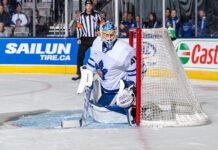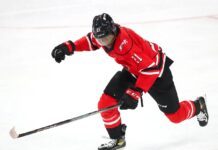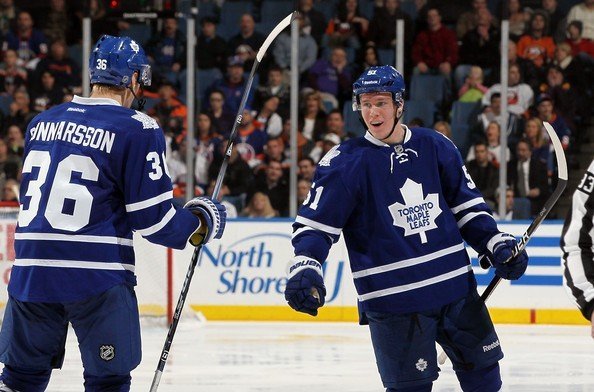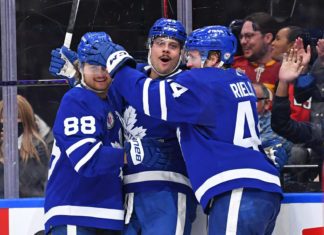First off, can I just say how excited I am about this coming season? Last year, I predicted that the Leafs would be a lottery team. I can only think of a handful of times I was happier to be wrong. In many ways, the 2013 Leafs finally defined the four tenets of Brian Burke’s promise – truculence, pugnacity, belligerence, and testosterone. There are few things more gratifying as a fan than to be able to puff out your chest the day after a win and say, this is my team.
A shortened season may have saved the Toronto Maple Leafs’ from the much touted ‘regression’ theorized on social media, but they did make the playoffs – and by doing so, ended the embarrassing drought of eight seasons without a post season appearance. A lot has been made of the reasons for the Leafs success last year, with much of those accolades going to James Reimer for his brilliant regular season performance, but there were some concerns of whether the Leafs’ defense could be credited for any of the team’s improvements.
In this post, I will explore the Leafs’ defensive roster, last year’s performance, and the expectations going forward. Warning: I will be using fancy stats. I realize that I can be critical towards those using Corsi and Fenwick as their dominant analysis, but much of my criticism has to do with context.
The Basics:
The Leafs opened the season without one of their promising mainstays from the year prior – Jake Gardiner. A concussion sustained prior to the end of the lockout forced Gardiner into an uphill battle to recovery that he would not overcome until much later leading into the playoffs. In addition, Mike Komisarek continued to underwhelm and was later sent down to the Toronto Marlies. The defense also featured several unknowns including Mike Kostka, Mark Fraser, and Carl Gunnarsson’s hip. Overall, the defense struggled with a combination of inexperience, injuries, rookies, and a new defensive system that advanced the puck pressure in the Leafs’ zone, but hurt the team’s ability to break out in the process.
The Issues:
Let’s start with the negatives to get them out of the way.
First off, the Leafs were thoroughly outshot last season. Further, let’s cut to the absolute truth – being outshot is usually a bad thing. I think when the argument between shot quality and shot quantity arises, the disconnect is that lowering scoring chances and shots are a necessary component of defense – something that the Leafs struggled badly at over the last several years, bad goaltending aside. It’s probably a chicken and egg problem – does limiting scoring chances lead to lowering shots, or does limiting shots lower scoring chances? Since I have not seen much work done on that theory, let’s move on.
The Leafs were historically bad with the shot differential. It was posited that historically, the team would be hard pressed to be even worse than they were last year. Since 2008, only one team gave up more shots per game than the 2013 Leafs – the 2008-09 Florida Panthers. Curiously, the Leafs were also bottom four in shots for – another wrinkle in the shots differential debate. Since 2008, the 2013 Leafs were 15th from the bottom for shots for.
If it sounds like I am being negative, it’s because I want to make sure I am offering fair and impartial analysis. I dislike beating a dead horse as much as anyone, but sometimes, the statistical issues raised have merits beyond the contextual beliefs we should also be adhering to. Historically, the shot differential was bad enough that the Leafs were (and I eye-balled this quickly) 5th from the being the worst team in shot differential since 2008.
The initial regular pairings were difficult to understand – starting Mike Kostka on the top-pairing with Dion Phaneuf was a season-long source of concern for many in Leafs Nation. While Kostka did admirably against the competition he faced with Phaneuf, he was consistently outmatched and struggled to move the puck. Oddly enough, Kostka’s Corsi Rel was surprisingly just above average – his Corsi On was also second on the team. A further look suggests that Kostka was on the ice more for offensive opportunities with the Kessel line, which explains some of the shot differential discrepancies.
Then we have Korbinian Holzer. I am hesitant to place complete blame on the player for his awful performance given that he was a rookie, playing extremely difficult minutes, and the alternative option to Kostka, given that Cody Franson was already providing the offense on the sheltered pairing. Further, Holzer’s statistical outputs were appalling. If shot differential is, at the very least an inferred proxy for possession, then Holzer’s entire season was one spent almost entirely without the puck. Holzer’s quality of competition was roughly third on the Leafs. But his Corsi Rel was an absurdly bad -24.2 (which is the statistical determination of how he performed on the ice vs. the team performance when he was off the ice). Putting in more layman terms, the Leafs were an infinitely better team when Holzer was off the ice. In fact, when I looked at Corsi Rel throughout the rest of the league’s defensemen who have played 20 games or more, Holzer was last. To say that Holzer was awful this season wouldn’t be critical enough.
Let’s add some positive context here. I have often felt that Holzer was forced into a difficult situation due to the organization’s need to add a physical element to Phaneuf’s right and to buy time for Gardiner’s recovery, who was slowly coming into form with the Toronto Marlies. If I am correct, Holzer was the sacrificial lamb to the league’s best so that Gardiner could develop and recover to management’s expectations. Whether this is a reasonable presumption, I don’t know.
Other disappointing features on the defense would be J.M. Liles, Komisarek, and Gardiner’s slow recovery, which I documented here.
The Good:
MLHS has expended a lot of effort of going over the positive things that have happened last year, so I will be brief here.
In a weird way, the Leafs’ unsteady rise to the playoffs parallels closely to the fan-base’s growing recognition of Phaneuf’s value to the Leafs. Not only did Phaneuf provide the shutdown defense needed to keep his team in the game, but his offense was top-ten among defensemen in the NHL. If you need further context for how good Phaneuf was last season, check out @MLHS_Mike’s Phaneuf for Norris post.
Quick recap: Phaneuf produced at a rate providing top-ten offense league-wide, facing the most difficult quality of competition among defensemen in the NHL, and carrying the burden of covering for the mistakes of Kostka and Holzer.
Without Phaneuf, the Leafs might have been a lottery team.
In addition, Cody Franson was a surprising positive. Two seasons ago, Franson struggled to acclimate to the team speed, often incurring the wrath of Ron Wilson. Typically, the knock against Franson was his below average defense, unwilling to use his gifted physical attributes, and his inability to quickly box out players below the goal line. Last season, not only did Franson finally start utilizing his size in the defensive zone, he finally broke out in the other end finishing with 29 points in 45 games – good enough for 8th overall among defensemen. While currently on a holdout, there’s a lot of untapped upside here – re-signing Franson is paramount to the Leafs success on special teams going forward.
Mark Fraser also surprised with his team commitment and work on the penalty kill. Overall, while the season was full of positive notes, the Leafs defense was a pretty good microcosm of the divide in Leafs Nation.
The Expectations:
So the last season summary that was longer than intended; it’s time to look at the expectations the Leafs defense might have.
I thought I would start by plagiarizing Petrielli’s line by line format for the defense. I will write with the expectation that Franson will re-sign with the Leafs though. As tedious as the process is for both player and team, it’s just as frustrating for the fans because we all want the best players playing on the ice.
First Pairing: Phaneuf – Gunnarsson
One unique twist to the growth of analytics is that they provide far more depth to their statistical charts. A good example of this is David Johnson’s website at www.stats.hockeyanalysis.com – we can pull data from Johnson’s site to see how the Leafs performed when Phaneuf and Gunnarsson were a pairing.
In a way, the Phaneuf – Gunnarsson pairing is actually a nice microcosm that explains the disconnect between tradition viewing and analytics – the results show what happened, but the question unanswered is why the results are what they are.
I wanted to focus on Phaneuf here because he’s the anchor of the Leafs defense and the team’s best defenseman. Starting with this chart we will focus on some of the glaring obstacles between traditional viewing and analytics. Note that you can chart the data using a graph – which makes the data easier to read.

The graph shows Phaneuf’s 2013 GF% season data and then compares his performance when paired with a certain player. Here, we have a pretty significant gap between Gunnarsson vs. Holzer and Kostka – the GF% of 68% indicates that when Phaneuf is paired with Gunnarsson, the Leafs scored at a rate of over 2 goals for to less than 1 against. Conversely, when Phaneuf is paired with Kostka or Holzer, the Leafs are scoring at a rate of less than 1 goal for to more than 2 goals against.
But Phaneuf’s overall Corsi For % (CF%) was absolutely brutal. That little number, that 41.9%, is one of the major reasons why so many online supporters of hockey analytics are critical of the Leafs – the seemingly incontrovertible evidence that Carlyle’s hockey decisions were running contrary to hockey trends. For 2013, Phaneuf’s CF% was not better with Gunnarsson; in fact, they were worse.
Going off course for a moment here, I want to explain why I was looking CF% — and analytics as a whole. During the summer, I got into an argument with someone who had the scoring chance data from the Leafs’ 2013 season – rather than share the data, he decided that it wasn’t noteworthy after spending the entire season publishing it.
Yet the Leafs defied that correlation with a scoring chance differential that conflicted with the shots differential data he had. While scoring chances and shots differential have been shown to be statistically linear (or very close to it), there’s also quite a bit of evidence that the Leafs season was also an outlier in that the measures of their negative possession would unlikely be duplicated.
Corsi and Fenwick are unique in that they don’t really track anything significant by individual shots – but taken as a whole, we’re able to get a good outline of the player and team’s performance in a specific situation against a specific player with a specific line-mate and so on and so forth. So while shots differential can be an excellent substitution, if not a replacement, for the eyes, so can scoring chance data. If the sample size of scoring chance to shot ratio is significant enough to draw a correlation between the two, then it is reasonable to assume that going further into the data would show that the variance of scoring chance data from player to player is likely a lot wider and provides ample player to player context. Certain players like Zdeno Chara can play defense at a high level, and they likely affect scoring chances in a positive way.
Unfortunately, I don’t have that data and I will likely never get it. Which is why I’m using CF% — it’s not perfect, but at least it gives me one side of the argument rather than nothing at all.
I will drop these two links for people to view on their own time.
The correlation of shot quality and quantity – shows a strong connection with Corsi and Fenwick
Does the Phaneuf – Gunnarsson pairing work even though their possession numbers were awful together last season?
The many issues were the difficulties in adjusting to a new system that not only took away a break out option, but required excessive communication between three players (D – C – D) rather than two. The system isn’t an easy one to master either – three players around the net or below the goal-line can be a confusing mess, especially when the puck isn’t on your stick. Having no lasting control of the puck around the net or below the goal-line limits the number of retrieval solutions and clogs the avenues a player can reach – which means the wingers have to stagger around the boards and near the points instead of being able to take off for a break out pass, which highlights the issue with shots against – less time to break out means less shots taken.
It’s a classic case of cause and effect.
More narrowly, I like to think the inexperience of Phaneuf’s partners and the forward group’s slow grasp of the system was to blame for the Leafs’ difficulty in retrieving the puck and moving it forward. Phaneuf’s best possession numbers with the Leafs have been predominantly with Gunnarsson: In the seasons previous to last, the Phaneuf and Gunnarsson pairing carried a reasonable CF% of 49.2%, 50%, and 54.9%.
This is a strong pairing. In the case of Phaneuf and Gunnarsson, there’s no real disconnect between traditional viewing and analytics – everyone can see that Phaneuf and Gunnarsson are a strong first-pairing and they have the offensive numbers and a history of decent shot differential averages to back it up. Going forward, we should expect a small regression as far as offensive totals per game goes, but we can expect a minor to substantial improvement for possession numbers from this pairing.
Second Pairing: Gardiner – Franson
This pairing is probably the only surprise of this post. I loved what I saw in the playoffs from both Gardiner and Franson. It was a surprise to everyone that watched the first round how dominant the Gardiner and Franson pairing was. And against the Boston Bruins no less.
Small sample sizes aside, hockey fans know that Gardiner’s skating is not of this Earth. His ability to skate himself out of danger and control the puck at high speeds are breathtaking. You might recall several instances in the playoffs where Gardiner decided to giddy up and throw on the afterburners, flying past the neutral zone traps the Bruins laid out for him, and creating a torrent of scoring chances.
Then we have Franson’s immense size and tremendous offensive abilities from the blue-line in. A wicked short shot, brilliant play-making potential, and an ability to control the point like no one else that plays the Leafs’ man advantage.
The surprising thing about this pairing isn’t that they were successful in the playoffs, but that we actually have more than 250 minutes of the two playing together back in 2011-12. That sample size isn’t exactly insignificant.
While the GF% was an excellent 57.7%, it was the CF% that surprised me given that Franson’s 2011-12 season was already pretty decent at 51.3% — the pairing worked together for a CF% of 53.6%. Turning that the data around on Gardiner’s 2011-12 season, he carried a CF% of 49.9%.
The pairing seems synergetic from a scouting standpoint too; immensely talented and fast Gardiner with Franson’s growing physical snarl and offensive precision. Defensively, they seem to have the potential to tighten their defensive coverage, but of course, it wouldn’t be a surprise to see them sheltered from difficult match-ups in order to best utilize their offensive tools.
Last season, I spoke often of Gardiner’s issues; whether it was in regards to Carlyle’s decision to sit him or the resulting fallout on social media. On one hand, there’s physical video evidence showing the many mistakes Gardiner made on his way out of the dog house. On the other hand, we have hours of Gardiner’s ability to skate himself out of trouble and create a chance. The best way to reconcile these two conflicting cases of both statistical theory and video evidence is to watch the results of Gardiner’s dominant play vs. his performance during the season – they aren’t remotely the same. To me, the issue lies not in the mistakes, but the interpretation of whether the statistical evidence that supports Gardiner’s ‘actual’ performance lines up with what we’re watching.
Last season, Gardiner ‘regressed’ against significant weaker competition. I paraphrased regressed because the numbers weren’t significantly different. And that’s the issue – Gardiner struggled to take a step forward. He was supposed to take a step forward. Sure, the coaching decision to sit him might not have helped, but we can’t ignore the mistakes, or the well-documented concussion he sustained prior to training camp. Nor can fans ignore the fact that he was left in the minors because he needed to get his timing back – it didn’t come back for quite some time, even after he was promoted.
To me, Gardiner represents the dividing line of glorifying aesthetically pleasing players vs. the ugly work that’s needed to support it. If Gardiner pulls his game together, there’s no real challenge that the second pairing can’t overcome.
Third Pairing: Fraser – Ranger
The life of a third-pairing is generally this:
a) You’re expected to not screw up;
b) You’re not going to be paid well relative to the rest of the league;
c) You’re expected to do the dirty work necessary to make life miserable for the opposition;
d) You’re probably going to bleed;
e) Make them bleed anyway;
f) Don’t screw up.
Fraser and Ranger provide both experience, toughness, and the smarts necessary on a third pairing. Technically, you might see some teams throw their rookies into the mix here, but not the Leafs – not unless Morgan Rielly proves to be ready. For the Leafs, they need stability, consistency, and mistake-free hockey from their third pairing so their top four can take risks and make mistakes that stems from those offensive risks they need to take.
Let’s talk about Fraser for a moment here. Fraser is a pretty decent third pairing option. He’s not flashy and has no measurable offensive talent, but he is a great representation of being a serviceable player who doesn’t really hurt your hockey team while providing both on-ice protection and toughness. This is the kind of player everyone can get behind – even the grumpy mathemagicians. Fraser embodies the dividing line between a hockey player and a ‘pure’ fighter.
Fraser had a remarkable season last year. In a way, he defied the expectations of his career and produced a season of proficient penalty killing and yeoman work on even-strength. I found it kind of funny that he ‘out produced’ Phaneuf in all notable categories, including goals for per 20, goals against per 20, and CF%. Of course, the context lies in two parts – one, he was paired with Franson, and two, he was facing pretty weak quality of competition. It is a unique quirk, but one already fleshed out quite a bit over on the Leafs Nation and Pension Plan Puppets.
On the other hand, Ranger is a much more difficult player to figure out. I caught a pretty good tweet from @schocker17 which encapsulates the growing excitement fans have for Ranger.
Ranger could be a real boon to the Leafs if he can play in the top 4 and a guy everyone will be rooting for.
— D Loop (@Dad_Loop) September 13, 2013
Ranger never really left. He never regressed. He never seriously hurt himself nor struggled with the rehabilitation process. He just dropped what he was doing, had his existential crisis, stayed in touch with the game from a distance, and quietly came back. Cam Barker, Ranger is not.
Steve Burtch from Pension Plan Puppets has building a case for his Shutdown Index (SDI) and has made several subtle references of his excitement for Ranger’s impact. I can’t find the section, but it was inferred that over the last several years, Ranger’s SDI score would rank him in the top-five had the minimum minutes needed to join the list been lowered to around 2,500 (another interesting tidbit is that Franson ranks very highly on this metric). Basically, if the metric is an accurate measure of a good shutdown defenseman, then Ranger will be the most significant addition to the Leafs’ defensive corp.
For the record, Burtch’s SDI work is really interesting. You should check it out sometime – Part 1 and Part 2.
Overall, the combined pairing shouldn’t be expected to score much, nor expected to see a lot of time against difficult competition, but they will be expected to make life difficult for the opposition. Penalty kill work will be a significant chunk of their duties, but we can also expect to see Ranger moved up a pairing and onto the power-play if he transitions seamlessly back into the league.
The Rest: Rielly, Liles, Holzer
I have made it known that I think Liles is as good as gone. He no longer fits in the top four and his defensive game is pretty poor. Last season, he produced at a CF% of 44.8% and a GF% of 47.1%, which is pretty disappointing for someone expected to produce, especially against weak competition. Another wrinkle is the concussion he sustained when Paul Gaustad caught him with his head down – the concussion parallels sharply with Tomas Kaberle who never was the same player after the head shot he sustained from Cam Janssen. If there’s potential for Liles improve, I don’t see it.
As I have already explained my dislike for Holzer, I don’t think I need to emphasize too much of my expectations for him. I think he is sent down to the Marlies, which the odd call-up here or there in event of an injury. In addition, I also expect him to be moved during the season; he no longer fits the team’s need for a quiet upgrade on the third-pairing. The Leafs already have Fraser and Ranger in the third pairing and the downside of playing Holzer isn’t really worth the risk of exploring the upside here.
However, Rielly will have a lot of ink spilled at his expense, with many writers, bloggers, and fans wondering what the best course of action is for his development. Already 6’1 and an athletic 205lbs, Rielly brings in a mix of good size, incredible skating ability and an unlimited array of offensive trickery from the back-end. Aside from the contemporary skill-set Rielly brings, he’s also a cheap alternative to Franson, providing the holdout lasts beyond training camp. Rielly is caught in a numbers game though; if Franson returns, the odds are against Rielly making the team. There’s no cap space and he would not get the minutes he would need to develop.
Other potential call-ups might be Jesse Blacker, Stuart Percy, and maybe Petter Granberg. I don’t want to spend any time on a long-shot because given their total NHL experience of no games played, it’s a little difficult to expect anything more than a cursory call-up for a show-me or an injury replacement.
The Conclusion:
As a rule, I try to temper my expectations going into the season. On the other hand, there were signs of huge steps taken by the defense during the playoffs. Of course, a sample size of seven games should never be used as a bargaining tool to confirm personal biases, but it is worth noting that the defense played to a role that has long been expected of them given their collective skillset.
A healthy roster, especially with Gunnarsson’s recovery from whatever hip issue ailed him last season, is a good omen for a team looking to improve on its defensive coverage and breakout proficiency. In addition, the growth of Franson and Gardiner, the return of Ranger, and the developing steadiness of Phaneuf’s two-way game should be a contributing factor. Moreover, understanding the nuances of the defensive system in place should resolve difficult situations – that same defensive coverage will improve if the forwards are more aware of their break out angling and board coverage.
I think this is a team ready to become playoffs regulars. Whether they take the next step to become contenders depends entirely on the defense being up to the task of using their impressive versatility to suppress shots against and scoring chances. I don’t think a duplication of last year’s shots differential is reasonable to expect.
This is a defense on the rise and there is more help coming.

































